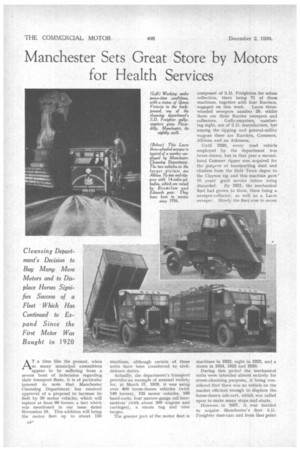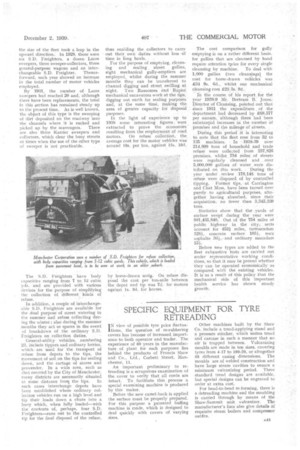Manchester Sets Great Store by Motors for Health Services
Page 46

Page 47

If you've noticed an error in this article please click here to report it so we can fix it.
AT a time like the present, when so many municipal committees
• appear to be suffering from a severe bout of indecision regarding their transport fleets, it is of particular interest to note that Manchester Cleansing Department has received approval of a proposal to increase its fleet by 30 motor vehicles, which will replace at least 60 horses, a fact which was mentioned in our issue dated November 15. This addition will bring the motor fleet up to about 170 machines, although certain of these units have been transferred to civildefence duties.
Actually, the department's transport provides an example of unusual variety for, at March 31, 1939, it was using over 400 horse-drawn vehicles (with 148 horses), 135 motor vehicles, 169 hand-carts, four narrow-gauge rail locomotives (with about 300 wagons and carriages), a steam tug and nine barges.
The greater part of the motor fleet is composed of S.D. Freighters for refuse collection, there being 71 of these machines, together with four }Carriers, engaged on this work. Lacre threewheeled sweepers number 20, whilst there are three Karrier sweepers and collectors. Gully-emptiers, numbering eight, are of S.D. manufacture, but among the tipping and general-utility wagons there are Karriers, Commers, Albions and an Atkinson.
Until 1920, every road vehicle employed by the department was horse-drawn, but in that year a secondhand Commer tipper was acquired for the purpose of transporting dust and clinkers from the Holt Town depot to the Clayton tip and this machine gave 10 years good service before being discarded. By 1921, the mechanical fleet had grown to three, there being a sweeper-collector, as well as a Lacre sweeper. Slowly the fleet rose to seven machines in 1922, eight in 1923, and a dozen in 1924, 1925 and 1926.
During this period the mechanical units were intended almost entirely for street-cleansing purposes, it being' considered that there was no vehicle on the market efficient enough to displace the horse-drawn ash-cart, which was called upon to make many stops and starts.
However, in 1927, it, was decided to acquire Manchester's first S.D. Freighter dust-cart and from that point the size of the fleet took a leap in the upward direction. In 1928, there were six S.D. Freighters, a dozen Lacre sweepers, three sweeper-collectors, three general-purpose wagons and an inter
changeable S.D. Freighter. Thenceforward, each year showed an increase in the total number of motor vehicles employed.
By 1931, the number of Lzicre sweepers had reached 20 and; although there have been replacements, the total in this section has remained steady up to the present time. As is well known, the object of this type is the sweeping of dirt deposited on the roadway into the channels where it is rucked and picked up by the scavengers. There are also three Karrier sweepers and collectors, which clear the busy streets at times when the Use of the other type of sweeper is not practicable.
The S.D. Freighters have body capacities ranging from 7 to. 12 cubic yds. and are provided with various devices' for the purpose of simplifying the collection of different kinds of refuse. •
In addition, a couple of interchangeable S.D. Freighters are available for the dual purpose. of street watering in the summer and refuse collecting during the winter ; also during the summer months they act As spares in the event of breakdown of the ordinary S.D.
Freighters on collection duties.
General-utility vehicles, numbering 23, include tippers and ordinary lorries, which. are used for the transport of refuse from depots to the tips, the movement of soil, on the tips for sealing down, and the cartage of stores and provender. In a wide area, such as that covered by the City of Manchester, many districts are necessarily situated at some distance frori the tips. In such cases interchange depots have been established where ordinary collection vehicles run on a high level and tip their loads down a chute into a lorry which, when fully loaded—with the contents of, perhaps, four S.D. Freighters—runs out to the controlled tip for the final disposal of the refdse, thus enabling the collectors to carry out their own duties without loss of time in long hauls.
For the purpose of emptying, cleans-. ing and sealing street gullies, eight mechanical gully-emptiers are employed, whilst during the summer months they can be transferred to channel digging and street swilling at night. Two Ransomes and Rapier, mechanical excavators work at the tips, digging out earth for sealing purposes and, at the same time, making the area of greater capacity for disposal purposes.
In the light of experience up to 1938 some interesting figures.: were extracted to prove the economies.' resulting from the employment of road motors. On refuse collection, the ayerage cost for the motor vehicles was around i0s. per ton, against 15s. 10d.
The cost comparison for gully emptying is on a rather different basis, for gullies that are cleansed by hand require attention tprice for every single cleansing by machine. To deal with 1,000 gullies (two eleansings) the cost for horse-drawn vehicles was £34 9s. 6d., whilst one mechanical cleansing cost £23 3s. 9d.
In the course of his report for the year 1938-0 Mr. Bertram B. Jones, Director of Cleansing, pointed out that since 1931 the expenditure of the department had decreased by £68,577 per annum, although there had been substantial increases in the number of premises and the mileage of streets.
During this period it is interesting th note that the fleet rose from. 52 to 135 machines. In 1938-39 over 214,800 tons of household and trade refuse were colle.-...ted from 237,826 premises, whilst 754 miles of streets were regularly cleansed and over 5,000,000 gallons of water were dis
tributed on this work. During the year under review 178,148 tons of refuse were disposed of by controlled tipping. Former tips, at Carrington and Chat Moss, have been turned over purely to agricultural purposes, altogether having absorbed, since their acquisition, no fewer than 3,345,330 tons.
Statistics show that the yards of surface swept during the year were 981,485,840. Out of the 754 miles of public highway in the city., setts account for 452i miles, tartnacadarn 1281., concrete surface 105i, rock asphaIte 3612-,, and ordinary macadam 15k.
Before new types are added to the fleet exhaustive tests are carried out under representative working conditions, so that it may be proved whether they can be operated economically as compared with the existing vehicles. It is as a result of this policy that the mechanical side of this important health service has shown steady growth.




































































